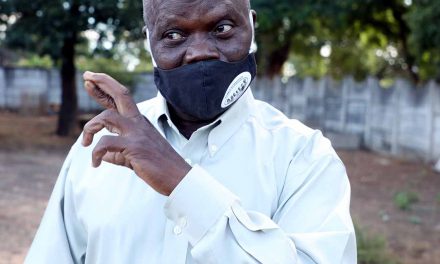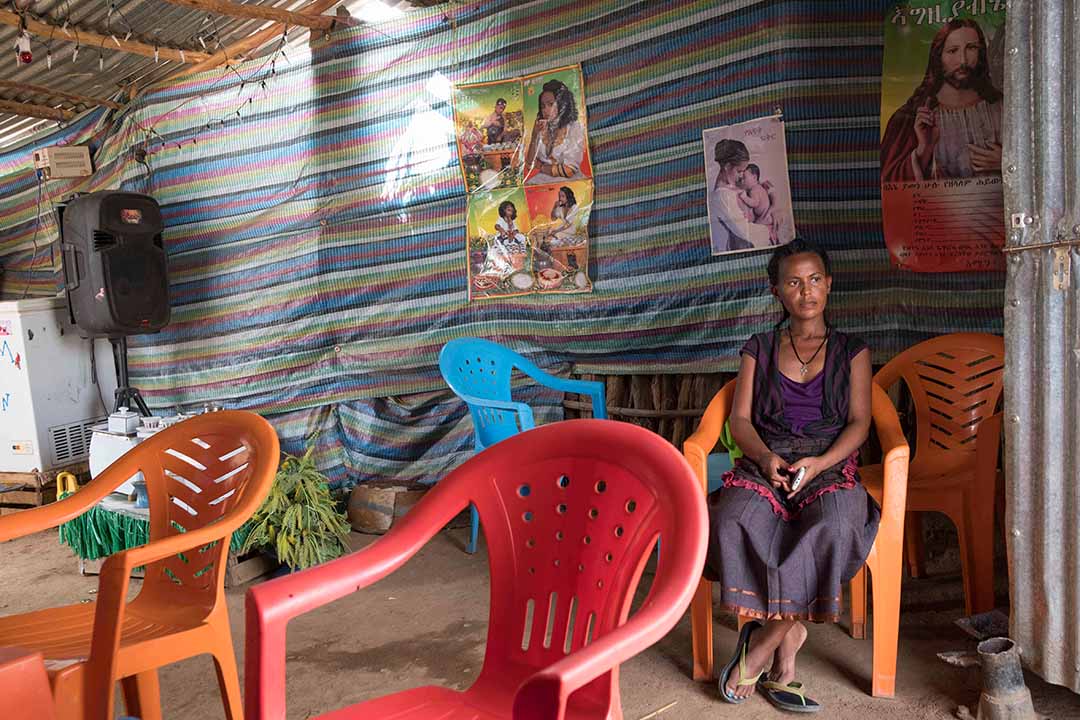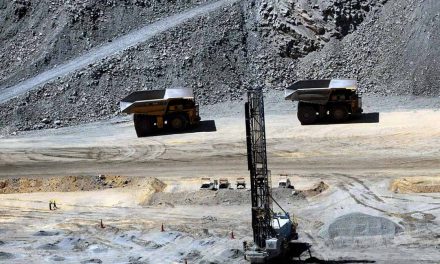Benedict Omondi, a farmer at Siteko Village, Busia County, western Kenya, is a bamboo farmer and a stakeholder in the Sio-Siteko transboundary wetland that traverses the Kenya-Uganda border.
The wetland covers an estimated 415 km2 and thousands of people live within its basin. According to global not-for profit Wetlands International, the once papyrus laden watershed has suffered from the onslaught of local communities who have turned it into farm and grazing land, with the widespread clearance of trees and the papyrus that conserves water.
But on a visit to Omondi’s farm, one is welcomed by chirping birds and the shade of the bamboo trees he has planted that have revived the section of wetland on his land and which hold the promise of regeneration for the Sio-Siteko wetlands as a whole.

Farmer Benedict Omondi on his wetland bamboo plantation in western Kenya. Photo: Justus Wanzala
A 2020 Wetlands International report noted that the Sio-Siteko wetlands faced many challenges to its survival, including a fast-growing population, high levels of poverty, and weak governance systems and structures.
But as a 2015 report by social networking conservation platform Tunza Eco Generation noted, bamboo is an effective tool both for reversing wetlands degradation and alleviating poverty. “No other woody plant matches bamboo’s versatility in environmental conservation and commerce to societies living near wetlands ecosystems and their associated riparian catchments areas throughout the world,” the report said.
Jackline Namadi, the coordinator of Eco-Green Kenya, a Busia based community organisation that promotes bamboo cultivation, agrees. She says they are working with other stakeholders to promote bamboo. “We work with the county government, the ministry of Environment and Forestry in Kenya, and conservation organisations and communities in Kenya and Uganda to conserve the wetlands and ensure livelihoods,” says Namandi.
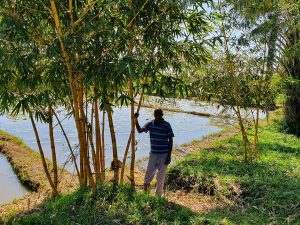
Benedict Omondi on his bamboo plantation. Photo: Justus Wanzala
Omondi, a pioneer bamboo farmer, is convinced that the initiative will aid in reducing degradation of the Sio-Siteko transboundary wetland that borders his land. He has planted more that 100 bamboo trees on his six acre farm.
He says that with the help of Eco-Green Kenya, he and other farmers also have a market for their bamboo, which is used in making beds, trays, tables, lampshades, baskets and in the construction of houses.
The income Omondi, a retired schoolteacher, receives from his bamboo has offered him a lifeline. “Each tree, when harvested, fetches Kenya Shillings 500 ($5). The bamboo shoots are also edible and have medicinal value, and the leaves are used to feed livestock,” he says.
Namandi says that, initially, local community members were sceptical about their prospects as bamboo farmers, with low adoption numbers, although farmers like Omondi who embraced the project have seen the benefits.
Robert Sunya, the Dutch Sino East Africa Bamboo Development Programme technical officer for the International Bamboo and Rattan Organisation (INBAR) says, “The future is bright; a county like Busia already has 4,000 bamboo farmers. It is high time students in tertiary institutions pursued bamboo related studies to start their own enterprises and harness available opportunities.”
Likewise, Dennis Chirande, director of Environmental and Natural Resources for Busia County, says the county government appreciates the role bamboo plays in conserving and regenerating local wetlands, and has submitted a strategy paper to promote its adoption.
Chirande says his department has a nursery with 10,000 bamboo seedlings to distribute to farmers living along the Sio-Siteko transboundary wetland. According to Chirande, bamboo cultivation will also increase tree cover in the county, which currently stands at less than 5% of the land.
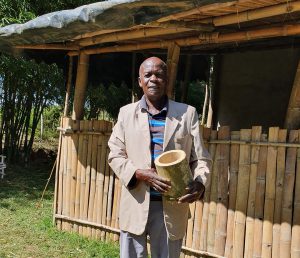
There have been challenges. In Busia, Namandi says, the bamboo seeds for the second phase of planting failed to germinate properly. Seedlings have also been regularly affected by seasonal flooding and livestock encroachment. “We plant the seedlings during the dry season to avoid the effect of floods, meaning they must be watered, which is costly,” she adds. “Erratic rainfall has also compelled communities around the wetland to invade it for food cultivation, because during droughts, it is the only land that has moisture to grow food and it’s fertile.”
There’s also been a problem with differing land tenure systems in Kenya and Uganda. Whereas Kenyan farmers have individual ownership of parts of the wetland and can easily make decisions on their use, in Uganda wetlands are communally owned, and are used for grazing land, which means collective decisions are required to change their use. “In Uganda it is difficult to change [wetland] use and some fear it will deny their livestock pasture lands,” says Namandi.
The impact of this variation in the laws of the two countries has led Eco-Green Kenya and its partners to sign conservation agreements with communities to ensure the focus is on collaboration and partnership to avoid programmes getting bogged down by legalities.
Further afield, Nellie Mugure Oduor, INBAR’s national coordinator, says its Dutch-Sino East Africa Bamboo Development Programme (which is in its second phase, 2020-2023) is underway in Ethiopia as well as Kenya and Uganda, funded by the Netherlands and China.
Programme objectives include creating sustainable and lucrative bamboo value chains for industry and small-to-medium enterprises by upscaling existing value chains and diversifying into new ones.
According to Oduor, the programme is expected to directly benefit some 28,500 people, as well as restore 5,000 hectares of degraded land with bamboo, and enhance sustainable management practices for 5,000 hectares of bamboo plantations and farms in the three countries. “The target groups are smallholder farmers, women, youth, small-to-medium enterprises and larger industries,” she notes.
In Cameroon, another INBAR programme is evaluating the potential of bamboo and other native, non-timber forest products to restore degraded land in the country and create new income streams.
In 2016-19 INBAR also successfully implemented a World Bank-funded programme in Ethiopia. Overall, Oduor says, 12 exotic bamboo species were introduced, two million seedlings produced and some 400 hectares of bamboo planted.
Another key INBAR project, she says, is located on the transboundary Mara River shared by Kenya and Tanzania. “This project includes restoring river banks along the Mara River by creating bamboo plantations on riparian zones, soil and water restoration, carbon sequestration estimated at 1,500 tons and improving the livelihoods of the communities,” she says.
According to the Consultative Group for International Agricultural Research (CGIAR)’s programme on forests, trees and agroforestry (FTA), Uganda also has a National Bamboo Strategy and Action Plan for 2019–2029, whose focus is on managing the country’s bamboo resources to provide economic, social and environment benefits for all.
In addition, in Kenya, there are collaborative efforts between stakeholders and the Ministry of Environment and Forestry to develop a bamboo policy and the creation of an enabling environment for bamboo value addition through, for instance, taxation and exploring the issue of product standards.
In addition, as the sector grows, the need for investment in capacity development and research in new technologies is emerging.
But while bamboo is a game changer in tackling climate change challenges, wetland degradation and the protection of livelihoods, Namandi emphasises that communities must take a leading role. “We work with many stakeholders, but to attain much, the ball is in the hands of individuals and their communities.”
Would you like to gain an understanding of your own impact on the environment? Calculate your own carbon footprint here
Justus Wanzala is a Kenyan journalist who writes on the environment, climate
change, agriculture and practical technologies as well as sustainable development and social issues. Currently, he works for the Kenya Broadcasting Corporation and as a freelancer/contributor for various publications across the globe.


